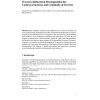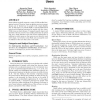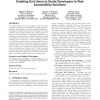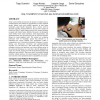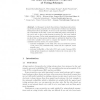113
Voted
ISAMI
2010
14 years 10 months ago
2010
Many adaptative context-aware middleware exist and most of them rely on so-called vertical architectures that offer a functional decomposition for contextawareness. This architectu...
164
click to vote
HVEI
2010
14 years 10 months ago
2010
This paper presents a novel system that employs an adaptive neural network for the no-reference assessment of perceived quality of JPEG/JPEG2000 coded images. The adaptive neural ...
101
Voted
ASSETS
2010
ACM
14 years 10 months ago
2010
ACM
Smart phones typically support a range of GPS-enabled navigation services. However, most navigation services on smart phones are of limited use to people with visual disabilities....
126
Voted
ASSETS
2010
ACM
14 years 10 months ago
2010
ACM
Few web developers have been explicitly trained to create accessible web pages, and are unlikely to recognize subtle accessibility and usability concerns that disabled people face...
139
click to vote
ASSETS
2010
ACM
14 years 10 months ago
2010
ACM
Touch screen mobile devices bear the promise of endless leisure, communication, and productivity opportunities to motor-impaired people. Indeed, users with residual capacities in ...
95
Voted
WOTE
2010
14 years 11 months ago
2010
83
Voted
WOTE
2010
14 years 11 months ago
2010
Abstract. In this paper, we study the problem of simultaneously achieving several security properties, for voting schemes, without non-standard assumptions. More specifically, we ...
104
Voted
WOTE
2010
14 years 11 months ago
2010
Optical mark-sense scanning has lead to a resurgence in the use of paper ballots in the United States, despite a century of strong competition from paperless direct-recording votin...
78
Voted
WOTE
2010
14 years 11 months ago
2010
Abstract. This paper presents a method for adding end-to-end verifiability to any optical-scan vote counting system. A serial number and set of letters, paired with every candidat...
108
Voted
WOTE
2010
14 years 11 months ago
2010
We present a K-out-of-L voting scheme, i.e., a voting scheme that allows every voter to vote for (up to) K candidates from a set of L candidates. The scheme is receipt-free, which ...
